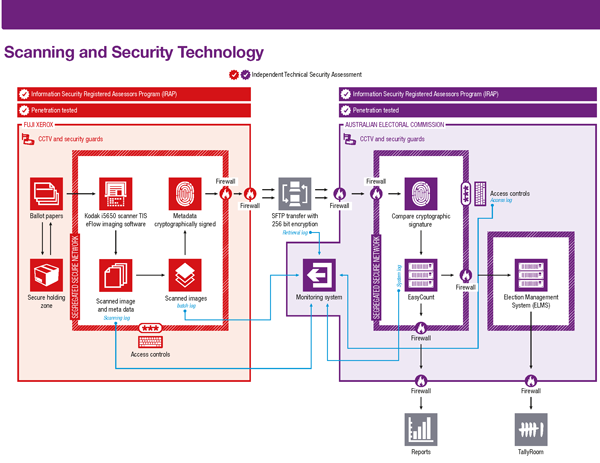New Senate count solution in 12 weeks
Changes to Senate voting at the 2016 Australian federal election substantially increased the complexity of the Senate count. Faced with a tight deadline before the double dissolution election on 2 July 2016, the AEC in partnership with Fuji Xerox Document Management Solutions was able to develop a new end-to-end solution involved scanning and image recognition technology in less than 12 weeks.
At the 2013 federal election, most people voted by marking a ‘1’ above the line, next to the group of their choice. The group voting ticket determined the flow of preferences.
Previously, only preferences expressed below the line, about 4 per cent of votes, needed to be recorded and entered individually into the count system.
The changes to Senate voting in 2016 required voters to express group preferences (at least 1 to 6) above the line, or individual preferences (at least 1 to 12) below the line. Consequently, preferences had to be entered into the count system for 100 per cent of Senate ballot papers – whether the ballot paper was marked above or below the line.
New semi‑automated solution
To ensure a workable count solution for the 2016 election, the AEC developed two potential solutions in parallel: (1) a semi‑automated vote scanning and new counting system; and (2) an enhanced EasyCount solution, using the AEC’s existing count application.
Developed in partnership with Fuji Xerox Document Management Solutions, the semi‑automated process was considered more robust, efficient and technically superior, and was adopted for the 2016 federal election.
The solution involved scanning and image recognition technology to capture preferences which were then visually validated by a human operator before being imported to the AEC EasyCount system for the distribution of preferences and declaration of results.
Central Senate Scrutiny Each state and territory established a dedicated Central Senate Scrutiny (CSS) site in their capital city. At the CSS, batches of Senate ballot papers were scanned using Kodak i5650 scanning hardware and entered into the TIS eFlow imaging software.
Optical character recognition technology captured voter preferences, with manual verification by a human operator. Once each Senate ballot paper is digitised and the marks interpreted by TIS eFlow imaging software, any ballot paper with unknown preferences or unusual markings is referred to a human operator for verification of the marks on the ballot paper
Once verified, a record, representing the preferences on the ballot paper, was generated and a cryptographic digital signature applied to protect each preference record from modification. The AEC then imported the preference record into the AEC EasyCount system for the distribution of preferences
Notable features of the solution included:
- a continual, trackable chain of custody for ballot papers
- human verification of every ballot paper
- full access for candidate scrutineers
- IT architecture and security standards to industry best practice.
The counting solution required the movement of approximately 14 million ballot papers from over 7,000 polling places to a Central Senate Scrutiny (CSS) site in each state or territory. At these sites, over 800 staff scanned and verified preferences for 631 candidates. From Tuesday 5 July, eight CSS sites operated five days a week, over two shifts. The AEC, with the assistance of the counting solution, successfully declared the eight state and territory senate results and returned the writs by 8 August 2016. The AEC is proud of its achievement given the short time provided in which to implement the changes.

Scanning and Security Technology developed for the 2016 Senate Election. Scrutineers may view the scanning, verification and adjudication processes. If they wish, they may raise challenges for adjudication by the Australian Electoral Officer (AEO).
